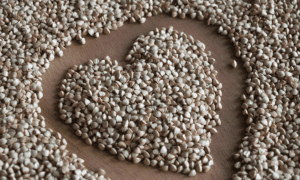Health Benefits of Buckwheat

With many health benefits of Buckwheat, there is a lot of fiber. Consuming fiber regularly promotes healthy bowel motions and lessens the likelihood of constipation and other related symptoms. Maintaining healthy digestive function is as easy as eating a high-fiber diet. Maintaining balance sugar levels is one of Buckwheat’s many essential functions.
If you are searching for gluten-free foods that still provide the health advantages of whole grains, you are in luck. Buckwheat is an excellent alternative to grains, adding a rich, somewhat nutty flavor that works well in many dishes.
What Are The Top Health Benefits of Buckwheat
Buckwheat is a member of the Polygonaceae family of knotweeds. Due to its grain-like seeds, it is a popular cover crop and food source. In the sixth millennium BCE, what is now Yunnan Province in southwestern China was the original home of buckwheat farmers. Several other species share the name “buckwheat,” including the domesticated Asian food plant Fagopyrum tataricum.
Despite the similarities in sound, Buckwheat is quite distant from wheat. Buckwheat defies categorization as either a cereal or grass. It shares a family tree with rhubarb, knotweed, and sorrel. The high starch content of buckwheat seeds makes them suitable for cooking, similar to cereal, hence the pseudocereal classification.
Health Benefits of Buckwheat
The Polygonaceae family of plants contains rhubarb and common Buckwheat (Fagopyrum esculentum Moench), both of which are gluten-free.
2 Although it is now grown in many different ecological zones worldwide, including nearly every state in the US, Buckwheat originated in the hilly regions of southern China.
Although quinoa and Buckwheat are classified as pseudo-grains or pseudocereals, the common practice is to include them in the grain food category alongside oats, barley, rye, and corn because of their comparable nutritional content.2 Buckwheat is unrelated to wheat, even though it shares a name with wheat. Buckwheat is a common alternative wheat.
Buckwheat offers a wealth of nutrients, including resistant starch, fiber, complex carbs, vitamins, minerals, and several flavonoid antioxidants.
The anti-inflammatory, anti-oxidative, anti-diabetic, and heart-protective qualities make it a helpful meal.1 It’s a healthy substitute for wheat that those who are celiac, have wheat allergies, or are sensitive to gluten but not Celiac disease can eat.
Prepare This Mouth-Watering Garlic Shrimp Recipe
1. Plenty of Antioxidants


The principal flavonol antioxidant present in buckwheat rutin.1 According to a new research review, rutin has antioxidant and anti-inflammatory properties, which could make it worthwhile for neuroprotection.
This could include protection against Alzheimer’s, Parkinson’s, and Huntington’s. Current research, however, is preliminary and has only employed rutin instead of whole Buckwheat
According to another scientific assessment, Buckwheat, other pseudo-grains, and whole grains may have protective benefits due to their antioxidant activity. Antioxidants help to lower oxidative stress.
Cigarette smoke and other environmental toxins naturally produce molecules called free radicals, which are responsible for triggering this illness. When levels of free radicals are excessive, they damage cell DNA and raise the risk of diabetes and heart disease.
2. Aids Digestive Wellness
Buckwheat suits your digestive system because of its resistant starch, prebiotics, and dietary fiber.
Just one cup of cooked Buckwheat meets sixteen percent of your daily fiber needs. One of fiber’s most notable advantages is influencing gut motility (the transit of food and waste materials through the digestive system) and warding off constipation.
Optimal diversity of gut microbes supports anti-inflammatory and good immunological function, and fiber helps optimize this diversity.
The prebiotics in Buckwheat feed the good probiotic bacteria in your stomBuckwheat beneficial bacteria Lactobacillus, and Bifidobacteria are among these. In addition to improving gut permeability, prebiotics aid in reducing pathogenic (disease-causing) gut microorganisms.
The second point is crucial because a leaky gut, characterized by increased intestinal permeability, can lead to inflammation and disease by absorbing toxic substances into the bloodstream.
In conclusion, buckwhBuckwheatins resistant starch is an indigestible starch that occurs naturally in several foods.1 Gut bacteria convert resistant starch to butyrate and other chemicals that promote gut health (particularly lining health) and decrease inflammation. Furthermore, butyrate has the potential to shield the colon from cancer.
3. Could Rely on Diabetes Management
In the United States, the incidence of diabetes among persons aged 18 and up increased dramatically between 2001 and 2021.12 Buckwheat’s natural qualities could help ward off or control the disease.
The glycemic index (GI) of buckwhBuckwheatwer is higher than that of millet, spelled barley, and bulgur wheat, among other cereals. This causes a lower blood sugar peak and increases blood sugar levels more slowly over a longer period.
One pilot study found that buckwuck significantly reduced sugar levels compared to a white wheat bread reference meal. Buckwheat also improved glycemic control, or the regulation of blood sugar, since its consumption was associated with lower blood sugar levels and shorter durations of hyperglycemia compared to bread consumption.
Additionally, Buckwheat helps people with diabetes since it lowers insulin and blood sugar levels after meals, according to a scientific analysis. Rutin, an antioxidant, also helps insulin work properly.15 Buckwheat’s fiber content has also been the effectiveness of insulin in reducing blood sugar levels.
It is associated with a lower risk of developing type 2 diabetes. Its anti-inflammatory and insulin-sensitivity-enhancing properties could also be contributing factors.
4. Might Assist in Promoting Heart Wellness


The United States has the highest mortality rate due to heart disease. A “silent” form of the condition goes undiagnosed until the patient exhibits symptoms such as a heart attack, heart failure, arrhythmia, or irregular pulse.16
Eating buckwhBuckwheatelp keeps heart health in check, according to research. A meta-analysis of thirteen studies shows that buckwhBuckwheatan lowers blood lipids and total cholesterol.
Its capacity to normalize sugar levels and fiber, resistant starch, antioxidants, and plant protein may partly explain why it protects the heart.17 Notably, the latter is significant because there is evidence that having type 2 diabetes doubles the risk of heart disease.
Buckwheat is associated with heart health because of its fiber content. Studies have linked increased total dietary fiber consumption to reduced risk of cardiovascular disease.
Health Benefits of Chia Seeds: A Promising Tool for the Treatment of Metabolic Diseases
5. Potentially Assist in Maintaining a Healthy Weight
Obesity affects about 20% of American adults. It is associated with more risk of diabetes, heart issues, stroke problems, and even some types of cancers.
Several lines of evidence suggest that buckwhBuckwheatelp maintains a healthy weight. Among these is its capacity to increase fullness or satiety. Buckwheat outperformed other meals, including fava bean, green pea, hemp, and lupin, in a single trial that measured their ability to curb appetite and promote fullness.
Buckwheat fiber has been associated with weight loss and smaller waistlines .7 Buckwheat ‘siotics have anti-inflammatory properties and promote beneficial changes to the composition of gut microbes, both of which are associated with weight management.
Another way buckwuckwheat’stant starch may help with weight loss is by changing the bacteria in your stomach. According to the available research, an increase in the gut flora known as B., which decreases inflammation and repairs the gut barrier, hence decreasing fat absorption, is one mechanism by which this fiber-like chemical aids weight reduction.
Healthy Eating with Buckwheat
The cooked groats of buckwhBuckwheat from the roasted and dehulled seeds are one popular way to eat buckwhBuckwheatr cooking; one cup of buckwheat groats contains:
- Nutritional value: 156
- A gram (g) of fat
- The sodium content is 255 milligrams:
- Nutrients: 33.8 grams
- Present in 4.59 grams of dietary fiber
- Sugars added: 0 grams
- Content of protein: 5.73 grams
- A total of 0.246 milligrams (or 27% of the DV) of copper
- Total magnesium: 86.7 milligrams, which is equivalent to 21% of the daily value
- At 1.59 mg, or 10% of the DV, niacin is present.
Copper is an essential mineral for proper iron absorption and the production of healthy red blood cells in the body. It also bolsters the immune system, bones, blood vessels, and nerves and promotes overall wellness.
More than 300 of your body’s chemical activities need magnesium. This mineral helps with the normal functioning of the nervous, muscles, and immune systems, as well as stabilizing the heart rate and maintaining strong bones. In addition to aiding in energy and protein production, the mineral aids in controlling blood sugar levels.
Niacin, an essential B vitamin, is crucial in supporting this process. It also helps your skin, digestive system, and nerves.
Buckwheat Dangers


Buckwheat can cause an allergic reaction in some people. According to one study, 2 and 7 percent of people seen in international allergy clinics had buckwheat allergies. Anaphylaxis is a severe and perhaps fatal allergic reaction; people allergic to Buckwheat risk it.
Advice on How to Eat Buckwheat
Groats, flour, and buckwheat-based goods such as soba noodles and sprouted seeds are all readily available forms of buckwhBuckwheatwheat can be enjoyed in a variety of nutritious ways:
Make breakfast porridge with buckwhBuckwheatad of oats. On top of cooked buckwhBuckwheatnkle with nuts and fruit, or add sautéed veggies and avocado for a savory twist.
In several recipes, swap out the rice or quinoa with cooked Buckwheat. Try it in chilis, stews, grain bowls, and hot or cold side dishes with extra veggies and herbs.
Buckwheat flour can be used instead of regular flour when making pancakes, baked goods, bread, biscuits, or crepes.
Hot or cold soups, topped with various ingredients and sauces, are the perfect places to enjoy buckwheat soba noodles. Combine the tofu, vegetables, and peanut sauce, and toss the noodles with it.
Yogurt and açai bowls can be enriched with sprouted dehydrated Buckwheatad of granola.
A Concise Overview
A gluten-free pseudo-grain,Buckwheat has the same health benefits as whole grains. In addition to plant-based protein, it offers complex carbs, fiber, antioxidants, vitamins, and minerals.
Numerous health benefits have been associated with Buckwheat. Because of its unique nutritional profile and anti-inflammatory properties, it can reduce the risk of diabetes, cardiovascular disease, and obesity.
If you suspect an allergy to Buckwheat, it is best to avoid it until you are tested by an expert.
As a reader, I am incredibly grateful to you. If you want to read my next posts, which combine ideas from psychology, social issues, education, business, biographies, women, leadership, tourism, climate change, and many more, you should follow me. You may sign up for my email list if you want to receive notifications whenever I post a new article.




